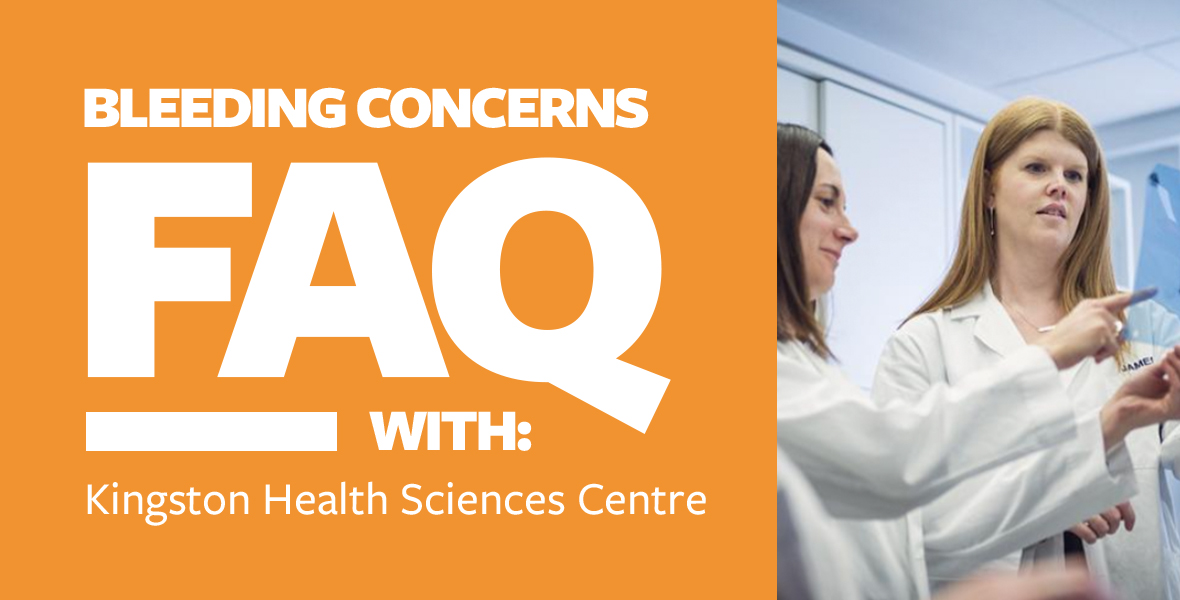Dr. Paula James about Bleeding Concerns
Explore the various frequently asked questions below about bleeding concerns. Also feel free to download or print the resource. Special thanks to the Kingston Health Sciences Centre team for verifying the information for the FAQs.
- My periods are really heavy, what is considered ‘normal’ bleeding during menstruation?
- What are some bleeding symptoms that might indicate an issue with bleeding?
- What are the most common bleeding disorders that affect women?
- What is von Willebrand Disease?
- What is Hemophilia A and B?
- What is Platelet Function Disorder?
- What are other Factor Deficiencies?
- What is iron deficiency?
- How do I get tested for a bleeding disorder?
- What happens after I get diagnosed for a bleeding disorder?
- Can I treat my bleeding disorder?
About the author
Let’s Talk Period aims to increase awareness of the signs and symptoms of bleeding disorders. As many as 1 in 1000 individuals may be suffering from a bleeding disorder, but many of these may not understand if their bleeding is normal or abnormal and therefore do not seek help. Through her internationally recognized research program at Queen’s University, Dr. James, Hematologist at Kingston Health Sciences Centre, and her team have developed a Self-Administered Bleeding Assessment Tool (Self- BAT) that will help inform people about their bleeding and guide them toward the help they need.
While normal is difficult to define, understanding what a heavy period is can be the difference between suffering in silence and getting the treatment you need. The medical term for heavy periods is Heavy Menstrual Bleeding (HMB). Signs of HMB are regularly having to change sanitary protection more than every hour, frequently soaking through pyjamas and bedsheets at night, being iron deficient, particularly if this leads to anemia or having periods that consistently last longer than 7 days. There are many different reasons why your period may be heavy. Sometimes, heavy periods can be a sign of an underlying inherited bleeding disorder (see below for symptoms of a bleeding disorder) Other times, heavy periods can be because of a problem with hormones, such as a thyroid disorder or another cause, such as uterine fibroids. This is why it is important to talk to your doctor if you have heavy periods. Know that you are not alone – almost one-third of people who menstruate report heavy periods at some point in their lives.
Symptoms of a bleeding disorder may include one or more of the following: Heavy or prolonged menstrual bleeding (menorrhagia), excessive bleeding from minor wounds, easy bruising, frequent and/or prolonged nosebleeds, bleeding from the gastrointestinal tract, excessive and/or prolonged bleeding after dental procedures (even just a cleaning), surgery, trauma or childbirth.
The most common bleeding disorders that affect women are von Willebrand Disease (VWD), Hemophilia A and B (Hemophilia Carriers), Platelet Function Disorders (PFD), and other factor deficiencies (such as FXI deficiency). Some people include disorders like Ehlers Danlos Syndrome in the list, and although it’s not caused by a problem with a hemostatic protein, it does present with bleeding symptoms.
Von Willebrand Disease (VWD) is the most common inherited bleeding disorder that we know about, and occurs in around 1 in 1000 individuals worldwide. VWD can be caused by genetic mutations that result in low levels of von Willebrand factor (VWF), or VWF that does not work properly. VWF plays a crucial role in blood clotting. As a result, people with VWD can experience problems with excessive or prolonged bleeding. The inability to form a clot is a particular risk during surgery, when the bleeding can be difficult to control. There are three types of VWD, Type 1, Type 2 and Type 3. People with type 1 VWD have low levels of VWF. This is the most common type (around 75% of people with VWD have type 1). People with type 2 VWD have VWF that does not work properly. People with type 3 VWD have very low levels of VWF. This disease type is more severe and is the rarest form of VWD.
Hemophilia is also an inherited bleeding disorder, less common than VWD. There are two main types of inherited hemophilia: Hemophilia A, the most common type, is caused by a deficiency of factor VIII, one of the proteins that helps blood to form clots. Hemophilia B is caused by a deficiency of factor IX. This type is also called Christmas disease. Women can be carriers of the hemophilia gene and also have hemophilia.
Many platelet function disorders may be mild so many women go undiagnosed. Depending on the type of platelet function disorder platelets may not stick to the walls of damaged blood vessels, may not clump together at the site of the injury to the blood vessel, or may not form a proper surface so that other blood factors can make a fibrin clot.
There are a large number of other bleeding disorders caused by deficiencies in trace proteins in the blood. Rare bleeding disorders include: deficiencies of coagulation factors fibrinogen, factor (F)II, FV, combined FV and FVIII, FVII, FX, FXI, FXIII, and congenital deficiency of vitamin K-dependent factors (VKCFDs).
A key component of hemoglobin is iron. Without enough iron, patients can have a low hemoglobin. The most common cause of anemia (low hemoglobin when measured by a blood test) worldwide is iron deficiency. Iron is a part of many foods – particularly meat, seafood and certain vegetables. Poor dietary intake can cause low iron. In Canada, iron deficiency is commonly caused by bleeding – usually heavy menstrual bleeding and/or bowel bleeding. Children undergoing rapid growth or pregnant women are also susceptible to iron deficiency. Symptoms of iron deficiency anemia include fatigue, weakness and lack of energy. In severe cases, shortness of breath and chest pain (particularly with activity) can occur. Brittle nails and hair loss are also associated. According to a recently published gynecology journal, up to 63% of women with heavy menstrual bleeding suffer from iron deficiency. Iron deficiency anemia can be diagnosed with two blood tests – the CBC (complete blood count) and a ferritin (iron stores) level. It is important to take iron replacement if you are iron deficient in order to replace iron stores as it is difficult to correct the problem by increasing dietary iron intake alone.
If you have some of the symptoms listed above and you have some questions about bleeding, a good place to start is by taking the Self-Administered Bleeding Assessment Tool (Self-BAT). Take the test here: https://www.letstalkperiod.ca/ self-bat/. You simply answer a few questions and the test will give you a score that indicates if you might have a bleeding disorder. After you take the test, if the score indicates you should speak to your doctor, the next step would be to make an appointment with your doctor to share your symptoms and your test score and request blood tests to determine if you have a bleeding disorder.
Discovering that you have a bleeding disorder can be alarming – especially if you are unaware of what it entails. It’s important to know there is help! After receiving a diagnosis for a bleeding disorder, you may be referred (or you can request to be referred) to a hematology clinic on your area. There are also 3 multidisciplinary clinics that specialize in women’s bleeding disorders: St. Michael’s Hospital, Kingston Health Sciences Centre and CHU Sainte-Justine.
There are many treatments available to help prevent and manage the symptoms of a bleeding disorder including intravenous (injectable) and oral medications, all depending on your bleeding type and concerns. This is something you could discuss with your hematologist or general practitioner.











